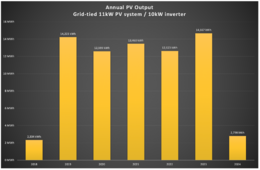wattmatters
Solar Wizard
It's optimistic for me as it has no capacity for fine tuning for various factors which impact production. It says we should have an annual generation of 16.148 MWh from our GT system.What trips me out is how good the online chart is at predicting solar output for the given location and azimuth of the panels.
I mean it's literally dead to nuts correct.
I used Pylon Observer to get the projected long term performance but frankly the variance year to year in performance means they are no more than general indicators. Pylon Observer says an annual generation of 14.5 MWh.
This is our actual generation, can see substantial year to year variation, simply due to weather with both drought and flood years in there:

For short term forecasting (hours, days) of PV output I use Solcast, and have the API integrated into Home Assistant.
I use the forecast data to make calls on whether my off-grid PV may need supplemental battery charging assistance from the grid-tied PV, how much it needs and when to initiate it.

It's 7:45AM, dashboard shows battery at 68% SOC and needs 11.5 kWh to be fully charged (my battery cycles between 57% and 100%).
It also shows that my off-grid system today is forecast to have another 8.3 kWh of production remaining in the day, and since that's not enough on its own to complete a full charge, then the "Grid Charge Req'd" indicator is on and the automations handling supplemental charging are operating.
Can see it has (at that moment) assessed there is enough spare grid PV capacity to allow 20 A of supplemental charging. The EWMA (exponentially weighted moving average) Grid values tell it how much spare grid PV capacity there is (negative = exports) and so it adjusts the supplemental charge rate up and down to capture the excess while avoiding importing energy from the grid.




